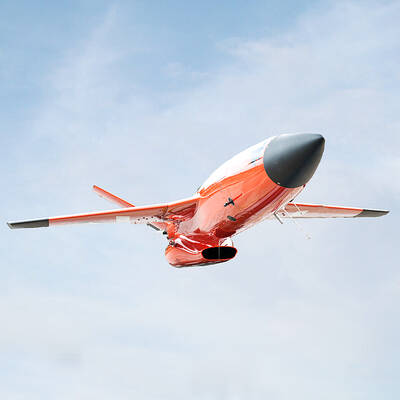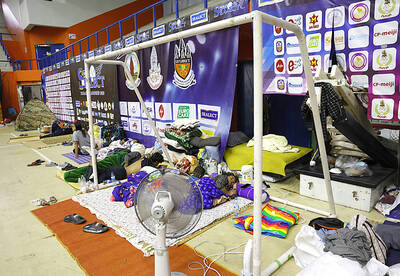A Japanese nuclear scientist and researcher says that if a nuclear accident occurred at one of northern Taiwan’s nuclear power plants, about 30,000 people would die within a short period of time and up to 7 million people could develop cancer from exposure to the nuclear radiation.
Hiroaki Koide, a nuclear reactor specialist who has been an assistant professor at Kyoto University’s Research Reactor Institute since 1974, spoke yesterday at a civic nuclear-free forum and met environmental protection groups in Taipei over the weekend.
During his speech, he said Taiwan has one of the highest densities of nuclear power plants in the world, which is why he chose to give his first overseas speech on nuclear issues in the country.
“Constructing nuclear power plants in Taiwan is very dangerous,” he said, stressing that the population density in northern Taiwan is so high that it would be very difficult to evacuate people if a nuclear accident were to occur at the Fourth Nuclear Power Plant in Gongliao District (貢寮), New Taipei City (新北市).
“The evacuation efficiency in northern Taiwan is virtually zero,” he said.
According to nuclear accident simulations he has run, people living in Taipei and New Taipei City’s (新北市) Yonghe (永和), Jhonghe (中和), Banciao (板橋), Sanchong (三重), Lujhou (蘆洲) and Pingsi (平溪) would all be directly affected by radiation, leading to an estimated 30,000 deaths in the first month after any such incident and up to 7 million possibly dying of cancer in the following years.
Nuclear power plants are not designed to be constructed on fault zones, he said, adding that Taiwan and Japan are both countries which suffer frequent seismic activity.
Therefore, it is very dangerous to have plants built on unstable strata, especially when operating power plants in Taiwan are considered old and the Fourth Nuclear Power Plant, which is under construction, is being assembled using components from different manufacturers.
Japan used to have high hopes for nuclear power, but since it began relying on it electricity prices have not dropped as much as predicted and the Fukushima Dai-ichi nuclear crisis last year has exposed many people to nuclear radiation, he said, adding “regrets will come too late if an accident occurs.”
He also suggested that if Taiwan can increase electricity generation from other power sources, it should close its existing nuclear power plants and halt the construction of the Fourth Nuclear Power Plant.
James Kuo (郭國榮), an engineer with 25 years of experience working on nuclear power at General Electric, also participated in the forum. He recently visited the Fourth Nuclear Power Plant and said the nation still lacks professionalism in managing nuclear power, adding that the government often misleads people by saying that nuclear power is a cheap means of generating electricity.
“Nuclear power may be cheaper, but operating costs and maintenance are more expensive, so hydroelectric power, wind power and even coal-fired power are all cheaper in the long-term than nuclear power,” he said.
Koide also met with an environmental protection group yesterday to exchange thoughts and experiences on nuclear power issues before leaving Taiwan.

‘WIN-WIN’: The Philippines, and central and eastern European countries are important potential drone cooperation partners, Minister of Foreign Affairs Lin Chia-lung said Minister of Foreign Affairs Lin Chia-lung (林佳龍) in an interview published yesterday confirmed that there are joint ventures between Taiwan and Poland in the drone industry. Lin made the remark in an exclusive interview with the Chinese-language Liberty Times (the Taipei Times’ sister paper). The government-backed Taiwan Excellence Drone International Business Opportunities Alliance and the Polish Chamber of Unmanned Systems on Wednesday last week signed a memorandum of understanding in Poland to develop a “non-China” supply chain for drones and work together on key technologies. Asked if Taiwan prioritized Poland among central and eastern European countries in drone collaboration, Lin

The Chien Feng IV (勁蜂, Mighty Hornet) loitering munition is on track to enter flight tests next month in connection with potential adoption by Taiwanese and US armed forces, a government source said yesterday. The kamikaze drone, which boasts a range of 1,000km, debuted at the Taipei Aerospace and Defense Technology Exhibition in September, the official said on condition of anonymity. The Chungshan Institute of Science and Technology and US-based Kratos Defense jointly developed the platform by leveraging the engine and airframe of the latter’s MQM-178 Firejet target drone, they said. The uncrewed aerial vehicle is designed to utilize an artificial intelligence computer

Renewed border fighting between Thailand and Cambodia showed no signs of abating yesterday, leaving hundreds of thousands of displaced people in both countries living in strained conditions as more flooded into temporary shelters. Reporters on the Thai side of the border heard sounds of outgoing, indirect fire yesterday. About 400,000 people have been evacuated from affected areas in Thailand and about 700 schools closed while fighting was ongoing in four border provinces, said Thai Rear Admiral Surasant Kongsiri, a spokesman for the military. Cambodia evacuated more than 127,000 villagers and closed hundreds of schools, the Thai Ministry of Defense said. Thailand’s military announced that

CABINET APPROVAL: People seeking assisted reproduction must be assessed to determine whether they would be adequate parents, the planned changes say Proposed amendments to the Assisted Reproduction Act (人工生殖法) advanced yesterday by the Executive Yuan would grant married lesbian couples and single women access to legal assisted reproductive services. The proposed revisions are “based on the fundamental principle of respecting women’s reproductive autonomy,” Cabinet spokesperson Michelle Lee (李慧芝) quoted Vice Premier Cheng Li-chiun (鄭麗君), who presided over a Cabinet meeting earlier yesterday, as saying at the briefing. The draft amendment would be submitted to the legislature for review. The Ministry of Health and Welfare, which proposed the amendments, said that experts on children’s rights, gender equality, law and medicine attended cross-disciplinary meetings, adding that